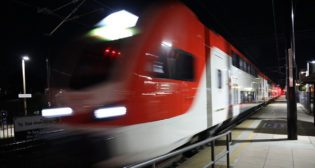
Texas Central taps RES for green duties
Written by William C. Vantuono, Editor-in-Chief
Private high-speed rail developer Texas Central has contracted with Resource Environmental Solutions (RES) for ecological mitigation services “to help protect and enhance natural ecosystems and the environment throughout construction and operations.” RES will oversee plans to comply with U.S. Army Corps of Engineers (USACE) requirements that the project “restore, enhance and preserve wetlands, streams and environmentally sensitive habitats along the train’s route between Houston and North Texas.”
RES, described as “the largest ecosystem restoration provider in the U.S.,” will help Texas Central “meet or exceed regulatory requirements for environmental mitigation, and will collaborate with community leaders to identify local and regional conservation opportunities. Over the past decade, the company, in projects across the country, has restored more than 58,000 acres of wetlands, enhanced more than 290 miles of streams and planted more than 14 million restorative trees,” Texas Central said. “RES has led several high-profile projects across the state and nation to safeguard local flora and fauna and the sensitive ecosystems they inhabit. Texas Central’s partnership with RES reflects its commitment to low-impact design strategies and environmental stewardship, avoiding and minimizing ecological effects during construction and operation of the passenger line.”
RES is charged with identifying isolated pockets along the route that require restoration, as well as entire complexes of streams and wetlands suitable for improvement and conservation. Specifically, RES will select mitigation sites and designs that collectively improve the ecological functions of broad areas, including some near the Trinity River, Navasota River, Spring Creek and Cypress Creek. RES said it “will develop a far-reaching plan to rebuild and restore wetlands and streams in the impacted watersheds as part of a comprehensive mitigation strategy. Preliminary ecological planning calls for stream and wetland restoration, enhancing the viability of several sub-watersheds close to the route.”
RES added that it “will help ensure that project meets or exceeds all environmental mitigation requirements and enhances local ecosystems and communities. This will help strengthen and connect wildlife habitat corridors, improve water quality along the route and increase flood resiliency. That work will be in collaboration with the USACE, which has solicited public comments on the Section 404 application now under review for the project.”
“The elite team of ecologists at RES will help safeguard local ecosystems, and this is one more example of our approach to protect the land and wildlife in a delicate manner,” said Texas Central Project Delivery Director Bill Tucker. “RES understands the importance that Texans place on preserving the natural beauty of our great state, and we are confident that this systematic approach to restoring and preserving sensitive ecosystems will result in widespread improvements across the region and beyond.”
“We believe that by engaging with partners dedicated to low-impact design and development, it’s possible to achieve both environmental sustainability and advanced infrastructure,” said Elliott Bouillion, RES CEO. “The Texas high-speed train is an excellent example of how a modern, green infrastructure approach can be harnessed for both ecological and economic benefits.”
Texas Central projects that its privately funded high-speed rail service “will remove more than 14,630 cars per day from Interstate 45, offsetting emissions in an area covering four counties that are in air quality nonattainment status. Compared to highway development, for every one mile of high-speed railroad tracks, about 450 acres of farmland will be preserved. The all-electric system will utilize the latest in green technologies, such as regenerative braking systems. It will use the newest generation of [Japanese] Shinkansen trains, the N700 Supreme, which consumes 7% less energy and weighs seven tons less than the previous model. Lighter trains result in less noise, vibration and impacts on materials and land. The route largely follows existing rights-of-way corridors, resulting in the fewest possible impacts to socioeconomic, natural, physical and cultural environments.”



